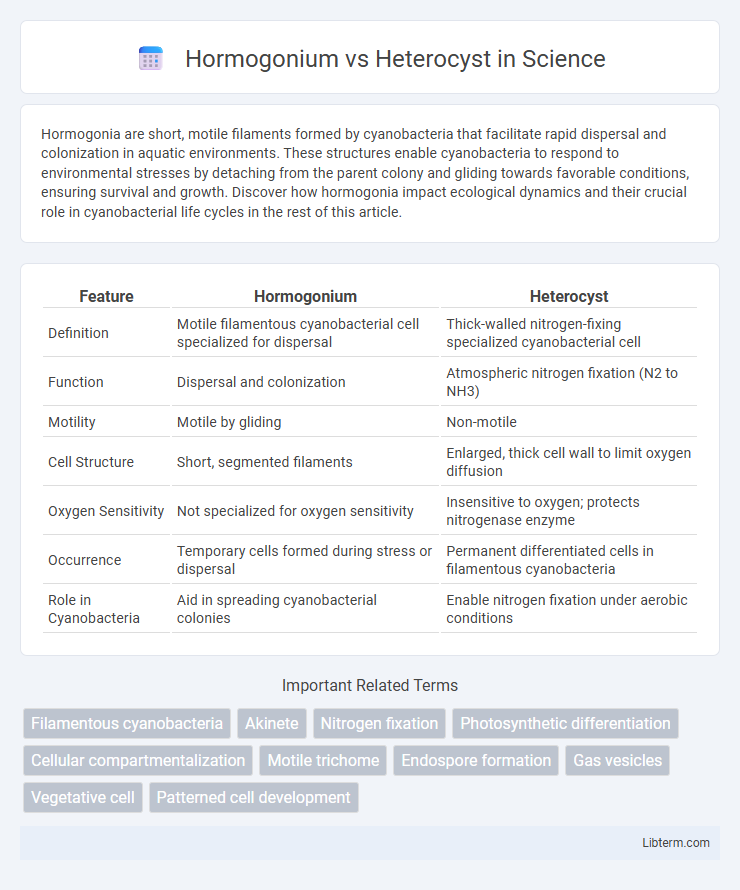Hormogonia are short, motile filaments formed by cyanobacteria that facilitate rapid dispersal and colonization in aquatic environments. These structures enable cyanobacteria to respond to environmental stresses by detaching from the parent colony and gliding towards favorable conditions, ensuring survival and growth. Discover how hormogonia impact ecological dynamics and their crucial role in cyanobacterial life cycles in the rest of this article.
Table of Comparison
| Feature | Hormogonium | Heterocyst |
|---|---|---|
| Definition | Motile filamentous cyanobacterial cell specialized for dispersal | Thick-walled nitrogen-fixing specialized cyanobacterial cell |
| Function | Dispersal and colonization | Atmospheric nitrogen fixation (N2 to NH3) |
| Motility | Motile by gliding | Non-motile |
| Cell Structure | Short, segmented filaments | Enlarged, thick cell wall to limit oxygen diffusion |
| Oxygen Sensitivity | Not specialized for oxygen sensitivity | Insensitive to oxygen; protects nitrogenase enzyme |
| Occurrence | Temporary cells formed during stress or dispersal | Permanent differentiated cells in filamentous cyanobacteria |
| Role in Cyanobacteria | Aid in spreading cyanobacterial colonies | Enable nitrogen fixation under aerobic conditions |
Introduction to Cyanobacteria
Hormogonia and heterocysts are specialized cells found in cyanobacteria, with distinct functions essential for survival and adaptation. Hormogonia are short, motile filaments responsible for dispersal and colonization, facilitating cyanobacterial spread in aquatic and terrestrial environments. Heterocysts serve as sites for nitrogen fixation under aerobic conditions, enabling cyanobacteria to convert atmospheric nitrogen into bioavailable ammonia, critical for growth in nitrogen-depleted habitats.
Understanding Hormogonium
Hormogonia are short, motile filaments produced by certain cyanobacteria for dispersal and colonization, enabling rapid movement away from unfavorable conditions. These structures lack heterocysts, which are specialized nitrogen-fixing cells found in some cyanobacteria that provide an anaerobic environment for nitrogenase activity. Understanding hormogonia is essential for studying cyanobacterial adaptation, reproduction, and their role in symbiotic relationships and ecosystem nutrient cycling.
Understanding Heterocyst
Heterocysts are specialized nitrogen-fixing cells found in certain filamentous cyanobacteria, enabling them to convert atmospheric nitrogen into ammonia under aerobic conditions, which is vital for their survival in nitrogen-poor environments. These thick-walled cells create a micro-oxic environment by restricting oxygen entry, protecting the oxygen-sensitive nitrogenase enzyme crucial for nitrogen fixation. Unlike hormogonia, which are motile reproductive filaments, heterocysts are dedicated to nitrogen fixation and do not contribute to movement or reproduction, emphasizing their specialized physiological role in cyanobacterial colonies.
Key Structural Differences
Hormogonia are short, motile filaments of cyanobacteria composed of vegetative cells that lack heterocysts, enabling rapid dispersal but limited nitrogen fixation. Heterocysts are specialized, thick-walled cells differentiated from vegetative cells, characterized by their enlarged size, lack of photosystem II activity, and the presence of nitrogenase enzymes for efficient nitrogen fixation under aerobic conditions. The key structural difference lies in heterocysts' thickened envelope and altered internal machinery to protect nitrogenase from oxygen, unlike the thinner, more flexible hormogonia filaments.
Functional Roles: Hormogonium vs Heterocyst
Hormogonia function as motile filaments in cyanobacteria that facilitate dispersal and colonization by enabling the organism to move toward favorable environments. In contrast, heterocysts are specialized nitrogen-fixing cells that provide an anaerobic environment necessary for converting atmospheric nitrogen into ammonia, crucial for cyanobacterial survival in nitrogen-limited conditions. Together, hormogonia and heterocysts support growth and adaptation through motility and essential nutrient acquisition.
Formation and Development Processes
Hormogonia are short, motile filaments formed by cyanobacteria during fragmentation for dispersal, developing through specialized cell differentiation and breaking off from the parent filament. Heterocysts develop as thick-walled, nitrogen-fixing cells in response to nitrogen deprivation, involving cell enlargement, wall thickening, and biochemical changes to create an anaerobic environment for nitrogenase activity. Both structures result from complex genetic regulation but serve distinct roles: hormogonia for propagation and colonization, heterocysts for nitrogen fixation and vegetative cell support.
Environmental Significance
Hormogonia and heterocysts play distinct roles in cyanobacterial adaptation to environmental conditions. Hormogonia facilitate dispersal and colonization of new habitats, enabling cyanobacteria to respond swiftly to environmental changes, such as nutrient availability and light intensity. Heterocysts provide a specialized cellular mechanism for nitrogen fixation under aerobic conditions, crucial for sustaining ecosystem productivity in nitrogen-limited environments.
Nitrogen Fixation Capabilities
Hormogonia are short, motile filaments of cyanobacteria primarily involved in dispersal rather than nitrogen fixation, lacking specialized nitrogenase activity. Heterocysts are differentiated, thick-walled cells within certain cyanobacteria that provide a micro-oxic environment crucial for efficient nitrogen fixation by protecting nitrogenase from oxygen inactivation. The presence of heterocysts significantly enhances the nitrogen fixation capability, whereas hormogonia contribute indirectly by facilitating colony expansion and colonization.
Comparative Genetic Regulation
Hormogonia and heterocysts exhibit distinct genetic regulation mechanisms essential for their specialized functions in cyanobacteria. Hormogonium formation is primarily controlled by genes regulating motility and differentiation under stress conditions, involving transcription factors such as HetR and PatS, which modulate filament fragmentation and cellular differentiation. In contrast, heterocyst development relies on the coordinated expression of nitrogen fixation genes (nif genes) and regulatory genes like hetR and hetN, which control heterocyst patterning and maintain the heterocyst's functional specialization for nitrogen fixation under nitrogen-deprived environments.
Applications in Biotechnology
Hormogonia and heterocysts play distinct roles in biotechnology, with hormogonia being utilized for biofilm formation and facilitating cyanobacterial dispersal in environmental engineering applications. Heterocysts are critical in nitrogen fixation, enabling sustainable agriculture through biofertilizers that reduce reliance on chemical fertilizers. Their specialized cellular functions are harnessed in bioprocessing to enhance biomass production and improve nitrogen availability in crop systems.
Hormogonium Infographic

 libterm.com
libterm.com